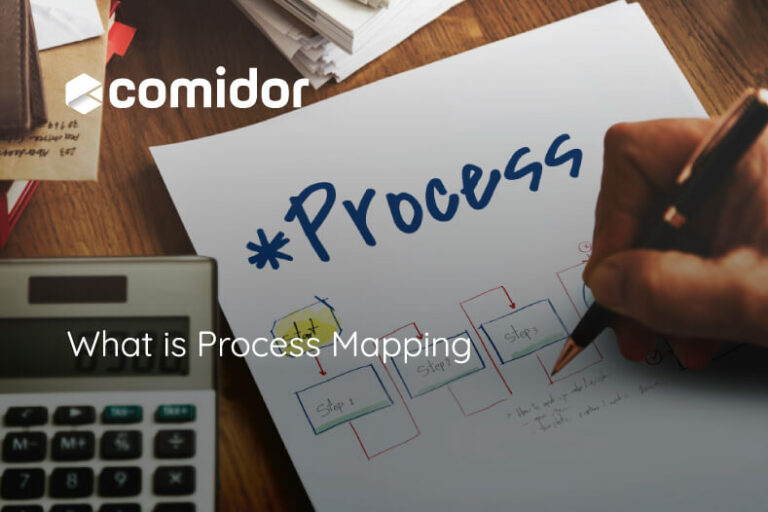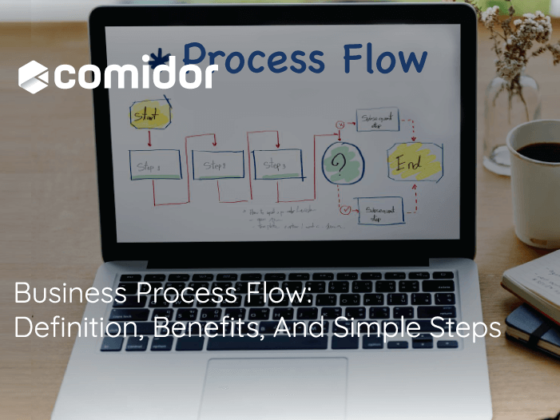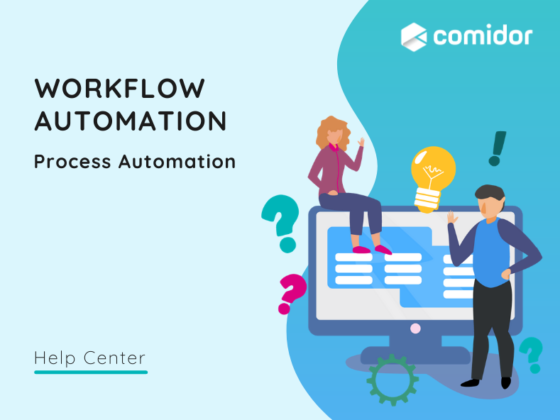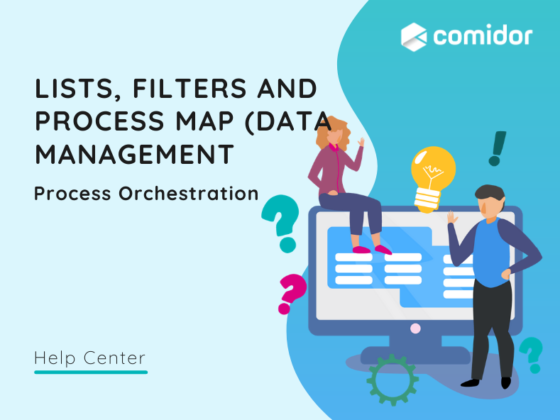Processes are at the heart of every business. Without business processes, tasks do not have a unified method of completion and data does not move through the pipeline properly. In order to fully establish these processes in your workplace, you need to know what they are going to look like. Process mapping has emerged to assist businesses in the planning of their daily processes. What is process mapping, you ask? We’ll answer this question and more below.
What is Process Mapping? – Definition
Business process mapping is not to be confused with business process modeling. Instead, process mapping is a technique that uses workflow diagrams to visually describe business processes. A workflow diagram shows the relationships between tasks and visualizes process information like the flow of work, who is involved in the process, what execution and quality standards are followed, and what is the expected outcome.
Process mapping is a part of business process management (BPM) and is usually implemented with the help of BPM software tools. Its main purpose is a deep understanding of the processes, internal transparency, and continuous improvement.
Diagrams help managers identify whether the execution aligns with the business values and objectives, measure performance, and become more effective. Business process analysis and visualization are also encouraged by ISO 9001: 2015, as it effectively contributes to quality management.
Benefits of Business Process Mapping
Companies and large enterprises all over the world use business process mapping to translate business data into useful information, identify improvements that can be made, optimize business processes, and become more effective.
With process mapping, process information becomes easily accessible and deeply understood by everyone involved while repetition mistakes are prevented. A flowchart can define the way in which processes should be executed ensuring that quality standards are followed every time the same workflow runs.
Business process mapping offers a variety of benefits your organization won’t want to miss out on, including:
- Defined norms. Without established processes, there’s no clear method on how to complete tasks. Once you’ve completed process mapping, your team will know exactly how to complete their tasks and move the process forward.
- Improved visibility. In addition to defined norms, you’ll also have clarity on who completes what tasks throughout the process. This will improve collaboration and increase transparency throughout the entire project.
- Increased productivity. Eliminating the confusion around processes, your team will be able to focus more on the tasks at hand and know how to complete workflows efficiently.
- Streamlined onboarding. As you bring on new team members, you’ll have a much clearer picture of how to train them on your processes and where they fit into the flow of work.
Investing in process mapping software can help you further automate your processes and start reaping the benefits quickly. Keep reading to learn more about how to do process mapping and where to find the best software.
How to Do Process Mapping
Knowing how to do process mapping is an essential part of creating business processes. To map a process, you should follow the steps below:
- Identify the process you want to map.
- Identify the purpose of the mapping: what you would like to optimize or measure.
- Set the start and endpoints.
- Analyze the process by identifying the activities and the connections between them.
- Set the sequence of the activities.
- Use basic mapping symbols to create the flowchart (for example you can use the BPMN 2.0 notation).
As mentioned above, you can use symbols and notations to visualize the information. Most of the time, process mapping tools with ready (drag and drop) symbols and connectors are used to simplify the flowchart creation.
Business Process Map Flowcharts
A flowchart is the most basic example of a business process map. It uses basic symbols to describe actions, activities, tasks, subprocesses, decision points, documents, the flow of work, completion time, events, gateways, people, and systems involvement.
The symbols are similar to UML symbols. The most common symbols used are:
- Circles: represent the start and endpoints
- Rectangular boxes: process steps (tasks, subprocesses)
- Diamonds: decisions that must be made to move on, they usually have two branches
- Arrows: represent connections between elements
Download the complete BPMN 2.0 Notation guide today to learn more about these symbols and how to use them.
When creating a flowchart, there are three main styles you can use to visualize your processes. These are:
- Basic flowchart. This flowchart uses a top-down identification method. When creating this flowchart, you’ll plot out all of the major tasks needed for a process. Jot down all of the subtasks that are done under each major task and evaluate your process from there. You’ll be able to pinpoint bottlenecks and see where you can automate or streamline repetitive tasks.
- Data flowchart. If your processes are data-heavy, this flowchart may be the best choice. Instead of tracking tasks, it follows the movement of data through the process. You can clearly see where data may get lost in translation or be inaccurately interpreted.
- Business modeling flowchart. For this flowchart method, you’ll want BPMN software. Using this process mapping software, you can create a diagram that depicts bottlenecks, repetitive tasks, and more.
Evaluate how you would like to visualize your process and choose a flowchart accordingly.
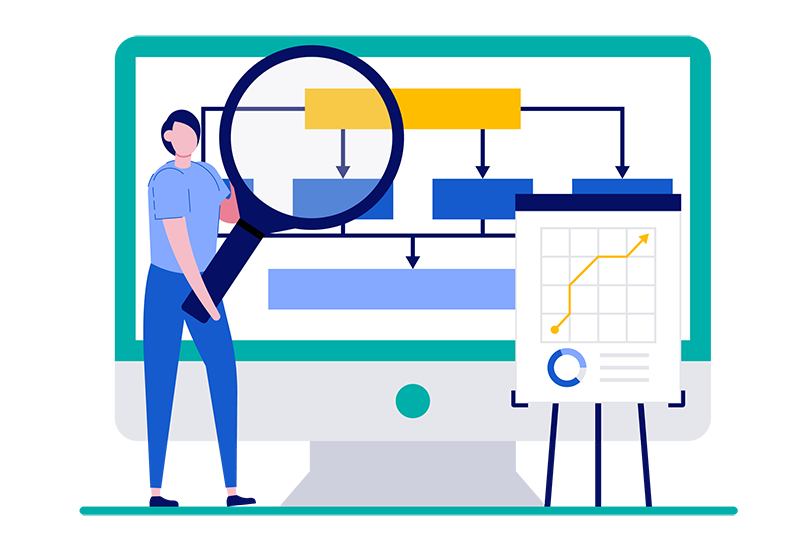 Process Mapping Tools
Process Mapping Tools
To start with business process mapping, you should carefully select your process mapping tools. Comidor is a powerful business process management platform with BPMN 2.0 drag & drop workflow designer.
Make process mapping a little easier by establishing your workflows as well. With definitive workflows, you can better visualize your overall process and place each workflow where it belongs along the way. Automate these workflows with ease using the BPM 2.0 Comidor Workflow Designer.
Process Mapping Examples
We’ve outlined just a few process mapping examples to give you a better idea of how you can utilize this technique in your own workspace.
Employee Onboarding
Onboarding new employees often comes with a monumental amount of paperwork and bottlenecks that are much too time-consuming. You can use process mapping to layout your traditional process for onboarding and identify where these bottlenecks can be automated.
Then, using BPM software, you can create automated workflows and manage your HR processes without the repetitive and time-consuming tasks taking up your entire day. Your HR team and the candidates they’re contacting will appreciate the streamlined process.
Project Management
Massive projects can easily be sidetracked when team members do not have clarity on their tasks or are unable to collaborate effectively. By completing process mapping, your team can better understand their role in the project and to whom they can communicate questions. They will also more clearly see where bottlenecks are holding up the process and how they can support each other through project management.
Sales Approval
The next process mapping example we’ll be discussing is sales approval. Sales teams understand just how tedious their tasks can become. With so many requests and approvals flooding in, it’s easy to become overwhelmed and fall behind. By reviewing your process through business process mapping, you can identify opportunities for automation and speed up your approval process.
Purchase Order
Finally, we will be presenting the purchase order example. Every business deals with procurement projects on a daily basis. A purchase order can be modeled using RPA easily. RPA software enables businesses to automate the creation of documents, saving time, eliminating typography errors, and boosting productivity. Here is a short video that shows you how to use the Comidor RPA Document Creator tool in a real-life procurement project.
Comidor Process Mapping
With an emphasis on business process management, Comidor understands the need for clear and concise processes. That’s why we’ve developed our BPMN 2.0 designer.
With this visual designer, you’ll be able to map out your processes from start to finish with ease. Identify bottlenecks and areas of improvement quickly and create automated solutions at your fingertips. Request a demo of our latest version today!
Map and optimize any process in your business


